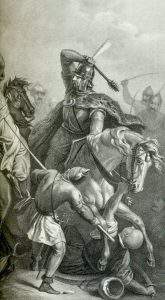Each day at noon, the bells toll to commemorate one moment in European history bearing crucial significance: the battle of Belgrade, where János (or John) Hunyadi triumphed over the Ottoman forces. Hunyadi is not just ‘Christ’s Champion’, who secured Europe for decades from the Ottoman Empire, but also the father of one significant ruler in Hungarian history, King Matthias Corvinus.
Word says…
There are a lot of mysteries surrounding Hunyadi, regarding his origins and birth. Some urban legend claims that he is of Romanian origins, which is supported by the fact that his full name bears reference to Romanian titles: John Oláh Hunyadi. ‘Oláh’ is the old Hungarian word for Wallach, which used to be an exonym of Romanians in the Middle Ages. Furthermore, he is described by a French chronicler as ‘The White Knight of Wallachia’, Wallachia being a historical part of Romania.

There are also several doubts regarding his parentage, stemming from the fact that the identity of his mother is lost. There are references that state that his mother was a Greek woman, but again others claim that she was of Romanian ancestry.
Rumours were circulating in those days that Hunyadi is actually the bastard son of King Sigismund
and that Voyk, the man who claimed to be his biological father, was a nobleman who was granted land and title in order to silence him and to thank him for raising John instead of the royal family. This was later regarded as gossip, which was spread by Ulrich II, Count of Celje, John’s rival, as the chronicler Antonio Bonfini revealed.
There is another version involving King Sigismund, this time, however, claiming that John was the legal son of King Sigismund and Queen Mary, but the child had to be hidden to be protected, thus Voyk and his wife raised him.
A man of great influence
Hunyadi served as the very first governor of the Kingdom of Hungary between 1446 and 1453, after Sigismund died and his successor, Ladislaus V was yet to come of age. Even after Ladislaus V commenced the throne, John was welcome to the Diet of Hungary, where his opinion was respected until the day he died.
As a sign of recognition, the Diet offered the Castle of Buda to Hunyadi to occupy as his residence in 1447.
In his time, Hunyadi was probably the second wealthiest person in the Hungarian Kingdom right after the royal family.
However, he used his money to finance the years-long campaign against the Ottoman Empire.
Great victory despite tragic losses
Although John Hunyadi is best remembered for the Battle of Belgrade (July 21-22, 1456), he and his troops had to suffer through terrible losses before they could destroy the Ottoman forces. After a series of victories over the Ottomans between 1441 and 1443, his army was defeated almost completely on two occasions. The first heavy defeat was at Varna in 1444, where Hunyadi was even captured by Vlad II Dracul (yes, that is Count Dracula). The defeat resulted from a premature charge by the young king Ladislaus who was even killed, thus panic ensued in the Hungarian army, which the Ottomans used for their good. The second one was at Kosovo in 1448.
Athleta Christi
Seeing the successes of the Hungarian governor against the Ottoman Empire, Pope Pius II not only supported his crusade-like efforts but also
gave him the title ‘Athleta Christi’, which translates to ‘Christ’s Champion’.
Hunyadi was well-respected all over Europe for the protection of the Balkans.
John is not only a national hero in Hungarian history but in Romanian history too. There are several streets, boulevards and statues commemorating him in Budapest, Varna and there is even a statue of him at the Museum of Military History in Vienna.
featured image: WikiCommons – Thaler Tamas
ATHLETA CHRISTI was also given to George Kastrioti or Skenderbeg of Albania during the same time. These are the only two that have this title. So they both saved Europe and Skenderbeg saved Southern Italy from the Ottomans.
Skenderbeg is sketchy because he did turn on Christian Europe and allied himself and army with the Ottomans. He did not save Europe.
Ok, how is all of Europe = saving southern Italy?? Also, the Hungarian army already had south Italy once for a reason and could do it again if it had to.
Edward, where did you find that Skenderbeg allied with the Ottomans?
Jimmy, I read it years ago in an old English encyclopedia-maybe around 1860. You can research Skanderbegs service with the Ottomans on-line.
Stephen the Great= ATHLETA CHRISTI in 1475
Stephen the Great= ATHLETA CHRISTI in 1475